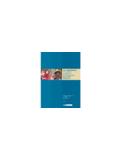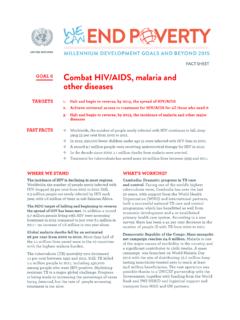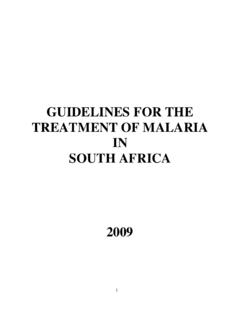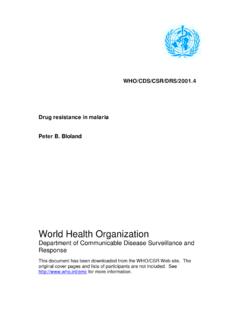Transcription of The Global Malaria Action Plan - UNHCR
1 THE Global Malaria Action PLANFor a Malaria free 23:22:20 THE Global Malaria Action PLANFor a Malaria free 23:22:20 THE Global Malaria Action PLANFor a Malaria -free worldCopyright 2008 Roll Back Malaria Partnership This document may be freely reviewed, quoted, reproduced and translated, in part or in full, provided that the source is acknowledged. Photographs are subject to licensing fees and may not be reproduced freely. The geographical designations employed in this publication do not represent or imply any opinion or judgment on the part of the Roll Back Malaria Partnership on the legal status of any country, territory, city or area, on its governmental or state authorities, or on the delimitation of its mention of specific companies or of certain manufacturers' products does not imply that they are endorsed or recommended by the Roll Back Malaria Partnership in preference to others of a similar nature that are not mentioned or 23:22:20It is imperative that universal coverageof prevention and treatment for themillions of people who suffer and diefrom Malaria is attained.
2 The GlobalMalaria Action plan will guide and unify the Malaria community in its efforts to provide timely and effective assistance to endemic countries. With sufficient funding and political support, this plan will help us reap dramatic gains against Malaria in the coming Marie Coll-Seck, Executive Director of the Roll Back Malaria Partnership Table of Contents Acronyms and Abbreviations ..7 Foreword ..8 Executive Summary ..9 Part I: Malaria Today ..201. Introduction to the Global Malaria Action plan ..242. The RBM Partnership s Vision and Targets ..253. Global Burden and Coverage Today ..274. Funding for Malaria Today ..35 Part II: The Global Strategy ..401. Introduction to the Global Strategy ..442. Control: Overcoming Malaria ..47 a. Scale-up for Impact: Achieving Universal Coverage ..51 b. Sustained Control: Maintaining Coverage and Utilization ..643. Elimination and Eradication: Achieving Zero Transmission.
3 734. The Malaria Research a. Research and Development for New and Improved Tools ..83 b. Research to Inform Policy ..95 c. Operational and Implementation Research ..985. Costs and Benefits of Investment in Malaria Control, Elimination and R&D ..102 Part III: Regional Strategies ..1141. Introduction to Regional Strategies ..1182. Africa ..1203. The Americas ..1324. Asia-Pacific ..1435. Middle East and Eurasia ..154 THE Global Malaria Action PLANPart IV: The Role of the RBM Partnership ..1641. Introduction to the Role of the RBM Partnership ..1682. Resource Mobilization ..1794. Policy and Regulatory ..1835. In-Country Planning ..1896. Financing ..1997. Procurement and Supply Chain Management ..2038. Communication and Behavior Change Methodologies ..2109. Monitoring and Evaluation ..21710. Humanitarian Crises ..225 Appendices ..2291. Contributors ..2322. Glossary ..2393. Assumptions behind Current Burden, Coverage and Funding Estimates.
4 2444. Assumptions behind Country Implementation Cost Estimates ..2505. Assumptions behind Research and Development Cost Estimates ..2626. Compilation of WHO References ..269 THE Global Malaria Action PLAN7 THE Global Malaria Action PLANACTA rtemisinin-based Combination TherapyAIActive Ingredients (refers to the four AI classes of pesticides)ALArtemether-LumefantrineANCA ntenatal careASArtesunateBCCB ehavior Change CommunicationCQChloroquineEPIE xpanded Program for ImmunizationGMAPG lobal Malaria Action PlanHWGH armonization Working GroupIECI nformation, Education and CommunicationIPTpIntermittent Preventive Treatment in pregnancyIRSI ndoor Residual SprayingIVMI ntegrated Vector ManagementITNI nsecticide-Treated NetsLLINLong-Lasting Insecticidal NetsMAWGM alaria Advocacy Working GroupM&EMonitoring and EvaluationMDAMass Drug AdministrationMDGM illennium Development GoalMIPM alaria In Pregnancy MEEM iddle East and EurasiaMERGM onitoring and Evaluation Reference GroupNGONon-Governmental OrganizationNMCPN ational Malaria Control ProgramOROperational ResearchPARP opulations at risk of malariaPSMP rocurement and Supply Chain ManagementPQPrimaquineR&DResearch and DevelopmentRBM The Roll Back Malaria PartnershipRDTR apid Diagnostic TestsRTS.
5 SMost clinically advanced vaccine against P. falciparumRWGR esources Working GroupSPSulphadoxine-pyrimethamineSRNSub- Regional NetworksSSASub-Saharan AfricaSUFIS cale-Up For ImpactWHOW orld Health OrganizationWHOPESWHO Pesticide Evaluation SchemeWINS calable Vector Control Working GroupAcronyms and Abbreviations8 Many of us who have spent our lives working for human health and development understand the tremendous challenges that must be overcome to achieve impact at a Global level. Yet, we are driven daily by the desire to alleviate the unnecessary suffering caused by preventable impacts the lives of billion people in 109 countries each year, the majority of which are already among the world s most vulnerable. Current prevention and treatment tools have led to significant progress in Malaria control. With rapid scale-up of these interventions and continued investment in Malaria programs and research, we are confident that a Malaria -free world will be achieved.
6 Greater attention, stronger leadership and more resources are being devoted to Malaria control and elimination today than at any time in the past forty years. We are at a critical tipping point in the Global fight against Malaria . If we can bolster ongoing efforts, align leadership, build partnerships and leverage available resources, we can build the momentum needed to eliminate Malaria in a number of countries. However, if this momentum is not sustained, progress stalls and funding wanes, our failure comes at the price of millions of lives needlessly Global Malaria Action plan presents a strategy to achieve our shared vision of near zero deaths from Malaria and eventual eradication in the long term. A product of collaboration among hundreds of experts, this plan issues an urgent call for Action , critical to making our vision a reality. Every individual and organization reading this report has a vital role to play in building a world free of Malaria .
7 No single group is large enough, knowledgeable enough, or powerful enough to achieve such a goal alone. Malaria eradication worldwide will require leadership, management, resources and unwavering commitment at the community, national, regional and Global levels. In addition, it demands public, private and civil society partnerships, aggressive research and development, strong health systems, coordination of commodities and services, and the harmonization of Global support. The Global Malaria Action plan offers a strategic way forward for policy makers, advocates, health workers, donors, researchers and all those rallying against Malaria . Working together, many countries have seen a significant reduction in Malaria deaths in recent years. Looking ahead, this plan further equips us to tackle ambitious but achievable goals, including cutting Malaria cases worldwide in half by 2010 and reaching near zero deaths from Malaria by 2015.
8 With an unwavering commitment to end the scourge of Malaria and stop the millions of senseless, preventable deaths from the disease, we challenge those standing alongside us to utilize the guidance and innovation of this comprehensive plan as we work together for a Malaria -free Global Malaria Action PLANDr. Tedros Adhanom GhebreyesusChair of the Board, Roll Back Malaria Partnership Minister of Health, EthiopiaMatthew C. Lynch, PhDVice Chair of the Board, Roll Back Malaria Partnership Director, Global Program on Malaria , Center for Communication Programs, Johns Hopkins University Prof. Awa Marie Coll-SeckExecutive DirectorRoll Back Malaria 23:23:4910 Executive Summary 1. Introduction 12 2. Part I: Malaria Today 13 3. Part II: The Global Strategy 14 4. Part III: Regional Strategies 17 5. Part IV: The Role of the RBM Partnership 17 6. The Bottom Line 23:23:5112 Introduction Sustained country leadership and commitment are essential in overcoming Malaria .
9 The Roll Back Malaria (RBM) Partnership has developed the Global Malaria Action plan (GMAP) first and foremost to support countries. The GMAP provides a Global framework for Action around which partners can coordinate their efforts. Developed through an intensive consultative process, it consolidates the collective input of 30 endemic countries and regions, 65 international institutions and 250 experts from a wide range of fields. The GMAP presents (i) a comprehensive overview of the Global Malaria landscape, (ii) an evidence-based approach to deliver effective prevention and treatment to all people at risk and (iii) an estimate of the annual funding needs to achieve the goals of the RBM Partnership for 2010, 2015 and beyond. The GMAP is a living document: as approaches and tools evolve to fight Malaria , so will the plan . The GMAP outlines the RBM Partnership s vision for a substantial and sustained reduction in the burden of Malaria in the near and mid-term, and the eventual Global eradication of Malaria in the long term, when new tools make eradication possible.
10 To reach this vision, the targets of the GMAP are to: Achieve universal coverage, as recently called for by the UN Secretary-General, for all populations at risk with locally appropriate interventions for prevention and case management by 2010 and sustain universal coverage until local field research suggests that coverage can gradually be targeted to high risk areas and seasons only, without risk of a generalized resurgence;Reduce Global Malaria cases from 2000 levels by 50% in 2010 and by 75% in 2015;Reduce Global Malaria deaths from 2000 levels by 50% in 2010 and to near zero preventable deaths in 2015;Eliminate Malaria in 8-10 countries by 2015 and afterwards in all countries in the pre-elimination phase today; and In the long term, eradicate Malaria world-wide by reducing the Global incidence to zero through progressive elimination in countries. To achieve these targets, the GMAP outlines a three-part Global strategy: 1) control Malaria to reduce the current burden and sustain control as long as necessary, 2) eliminate Malaria over time country by country and 3) research new tools and approaches to support Global control and elimination efforts.

















